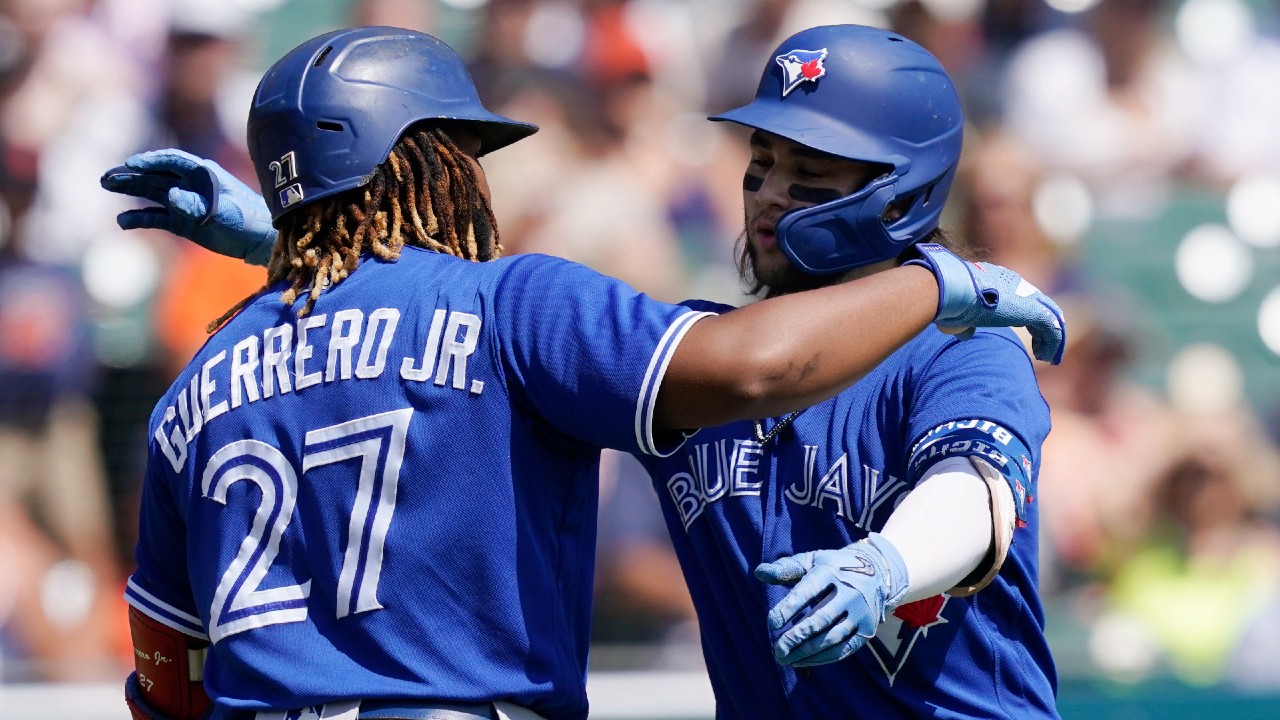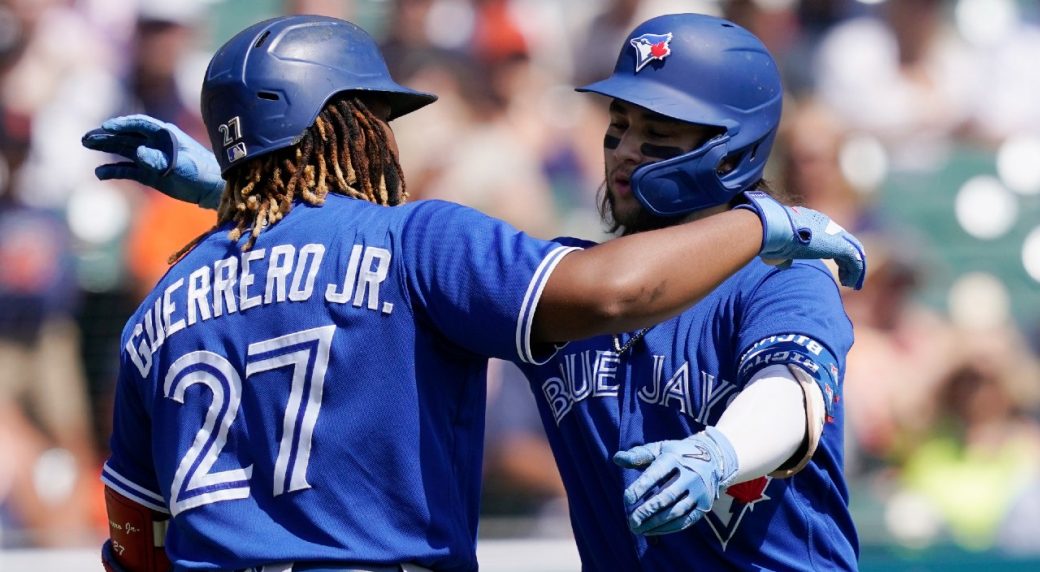

TORONTO – The stakes from Major League Baseball’s lockout of its players are intriguing for the Toronto Blue Jays, a team striving to continue its recent ascendency and re-establish its business after an extended pandemic displacement.
Clearly, how the sport’s economic framework changes in the next collective bargaining agreement is of pivotal importance, especially with discussions around arbitration, free agency and service time potentially impacting how cornerstones like Vladimir Guerrero Jr., and Bo Bichette are compensated and controlled contractually.
But there are other implications for the club from the sport’s first interruption since the players strike of 1994 – a dispute that badly impacted the Blue Jays – well beyond that, too.
Here’s a look at some local considerations amid an industry-wide dispute:
• Virtually every player in the majors is going through a labour interruption for the first time and it’s sure to colour their outlook moving forward. Ross Stripling is the club’s player-union rep along with alternates Randal Grichuk and Cavan Biggio and they regularly update their teammates via a 40-man group chat about the latest happenings. Biggio’s dad Craig and Bichette’s dad Dante were both part of the ’94 strike so they have some direct connection to labour conflict, but living it firsthand is another matter. The Blue Jays sought to make their player-development complex a year-round home for players, but now anyone on the 40-man roster is barred from using it, with access to other club services also cut off. Anyone who had been working at the pitching and recently completed hitting lab must now continue their training elsewhere. Expecting everything to be business as usual, then, once there’s a CBA in place runs counter to human nature, so keeping business from getting personal will be essential for the club.
• Any potential changes around arbitration, free-agency eligibility and service time calculations are by far the most pressing issue, especially with the Blue Jays having 10-arbitration eligible players, led by Teoscar Hernandez (second time) and Guerrero (first time), with Bichette and Jordan Romano slated to join next year. Right now, arbitration is the primary way in which young players escalate their salaries, sometimes in dramatic fashion. Guerrero, for instance, will jump from $605,400 to an estimated $8 million, so even a slight tweak to eligibility could mean significant additional costs. The push to raise the salary floor for 0-3 service time players would do the same. The Blue Jays are likely to carry at least six of those players and a raise to $1 million from the current $570,500 adds up to $2.6 million, or the cost of a bounce-back reliever (David Phelps’ minor-league deal, as an example, calls for a $1.75 million salary with $1.75 million in performance bonuses). Such changes are important, as they would help rectify a system that as designed largely rewards players once they’re past their prime and is a significant cause of the current friction. But it would also force all teams, especially one set up like the Blue Jays, to make adjustments in how their money is allocated.
• The potential impacts of free-agency eligibility and service time considerations are obvious. Anything that affects a club’s runway with a player is a massive shift and the Blue Jays are built around at least four more years of Guerrero and Bichette. The union has proposed a five-year free agency, according to commissioner Rob Manfred, which if not grandfathered in would get Guerrero and Bichette to market a year earlier. Manfred, however, called the union’s proposals for “a shortened reserve period, a $100 million reduction in revenue sharing, salary arbitration for the whole two-year class … bad for the sport, bad for the fans, and bad for competitive balance,” so clearly the owners are dug in on this. Regardless, any potential tweak is of major note, especially for the Blue Jays.
• Revenue sharing is a wider industry issue that doesn’t dramatically impact the Blue Jays, who are believed to be relatively neutral between what they put in and what they get out. But from a national perspective, larger-market clubs are in effect subsidizing small-market tankers through the teardown period, ensuring a revenue source while the timeout from competition is taking place. In theory, those teams are supposed to use money from revenue sharing to pump back into player signings, but the system has taken that money in a different direction. Any reduction in revenue-sharing contributions could empower richer teams to increase their payroll spending.
• The primary structural problem faced by the Blue Jays is the difference between the Canadian and American dollars, and that’s not really solvable within a CBA framework, especially when it’s a one of 30 issues (perhaps eventually to become a 1½ team issue). Local revenue for them, of course, arrives in Canadian dollars, but they do get a substantial amount of revenue from MLB distributions of national TV contract shares, etc. The gap between currencies right now is roughly 20 per cent, which is far more manageable than it was in the early 2000s, when the Canadian dollar dipped down into the 60-cent range. Back then, commissioner Bud Selig allocated roughly $5 million annually in currency equalization payments from his discretionary fund to help support the Blue Jays, but that practice was abandoned in 2009 and is unlikely to resurface.
• Raising the $210 million threshold for the Competitive Balance Tax, or CBT, is a fundamental issue for players, but Blue Jays payrolls have never approached that level and in October club president and CEO Mark Shapiro said crossing that line “is not something that we’re planning for as we sit here and look at the payrolls moving outward.” Why not is a discussion in and of itself, but within the current landscape, the CBT line has helped the Blue Jays by altering the spending patterns of the New York Yankees and Boston Red Sox, two of their key rivals in the AL East. The increasing penalties for consecutive years of excess has in recent years acted as a de facto cap on both teams, and any change in that regard would likely be met by spending hikes in demanding markets. Part of their current inaction is attributed to CBA uncertainty and is expected to change once there’s CBT clarity.
• The 1994 strike coincided with the Blue Jays’ decline after the consecutive World Series titles in 1992 and ’93 and the combination of a losing club and disaffection with the labour issue ate into what had been the sport’s most powerful fanbase. This time, they’re a team on the rise but one also seeking to resolidify its ticket base amid an ongoing pandemic that forced them through a nomadic journey from Buffalo to Dunedin to Buffalo before a Toronto homecoming. Worth noting is that this is a resilient market as despite only 36 Toronto dates with capacity limits of 15,000 and, for seven games, 30,000, at Rogers Centre, the Blue Jays still drew 805,901 fans. That was better than Baltimore, Tampa Bay, Oakland and Miami and just 55,000 fans short of surpassing Pittsburgh. The Toronto games totalled 604,835 fans, compared to 170,130 in 22 Buffalo home dates and 30,936 for 21 Dunedin dates, which bodes well for their future. But an extended lockout could arrest momentum and fans may become wary of committing money to games that could be lost in the dispute.
For the Blue Jays, stakes are high in first work stoppage since 1994
Source: Healthy Lifestyle
Mga Komento
Mag-post ng isang Komento